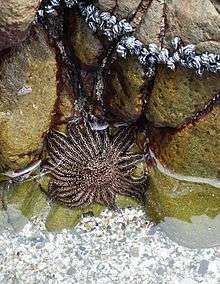Heliasteridae
| Heliasteridae | |
|---|---|
 | |
| Heliaster helianthus in Chile | |
| Scientific classification | |
| Kingdom: | Animalia |
| Phylum: | Echinodermata |
| Class: | Asteroidea |
| Order: | Forcipulatida |
| Family: | Heliasteridae Viguier, 1878 [1] |
| Diversity | |
| 2 genera, 7 species | |
The Heliasteridae are a family of Asteroidea (sea stars) in the order Forcipulatida. It includes two genera: Heliaster from the East Pacific (California to Chile, including offshore islands), and Labidiaster from southernmost South America, Antarctica and subantarctic oceans.
Genera
The World Register of Marine Species includes two genera and seven species within the family Heliasteridae:[1]
- Heliaster Gray, 1840
- Heliaster canopus Perrier, 1875
- Heliaster cumingi (Gray, 1840)
- Heliaster helianthus (Lamarck, 1816)
- Heliaster kubiniji Xantus, 1860
- Heliaster microbrachius Xantus, 1860
- Heliaster polybrachius H.L. Clark, 1907
- Heliaster solaris A.H. Clark, 1920
- Labidiaster Lütken, 1872
- Labidiaster annulatus Sladen, 1889
- Labidiaster radiosus Lütken, 1871
References
- 1 2 Mah, Christopher (2013). C. L. Mah, eds. "Heliasteridae". World Asteroidea database. World Register of Marine Species. Retrieved 2013-11-16.
| Wikimedia Commons has media related to Heliasteridae. |
This article is issued from
Wikipedia.
The text is licensed under Creative Commons - Attribution - Sharealike.
Additional terms may apply for the media files.